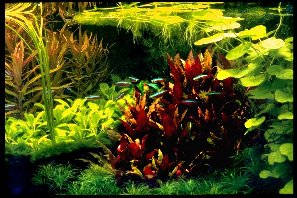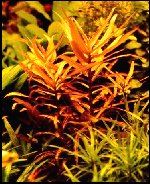


Red
plants in the architectonic aquarium
Things worth to know and hints
| The right part of the tank pictured on the previous page; the most powerful part. Often an aquarium is designed by the owner so that he, sitting in his chair, has the best view of it. In this case that sitting place was positioned on the left, so that this part in the appearance looks a little less beautiful. Mind the enormous depth effect that is caused by the Water Pennywort (Hydrocotyle leucocephale). Torn diagonally backwards, it is a good ceiling for the dark vista beneath. The set up in 4 plans at he bottom |  |
| * What is the cause of the red colors and how can we influence them? | |
| They mostly are caused by colorings like Anthocyanen, that arises from the influence of a lot of light, low temperatures during the night, high temperature during the day, dryness or other factors of "stress". They exist in different tints: red, lila, purple,and violet. These colorings are dissolved in the vacuole of the cells and protect the plant from burning. In flowers these colorings are frequently found too at flourish names like Pelargonidine for red, Cyanidine for yellow, Delphinidine for blue, paeonidine and so on. Mostly they are coupled with glucose, other sugars or complexes of aluminum of iron. Suchlike verbindingen and so the colors too are strongly influenced by the pH of the liquid in the cells. The green color, the chlorophyl, is concentrated in the chloroplasts. From a mixture of both these colors originate warm red and brown miscellany colors. By dosage of CO2 one can steer the pH, which increases the intensity of the colors. In this way a cooling down during the night is a mean to influence the intensity of exactly this anthocyan-color. So switch of the verwarming preferably with the lamps or better a little bit before with a separate time switch . And yet the red color not only serves the protection against to much light, which appears just of the red undersides of the leaves of f.e. Ludwigia, Lobelia, and particular Cryptocorynes, that show this red undersides already with a very low intensity of light. The the leaves of particular specimen of Althernanthera reineckii are juist at the undersides colored more lured. May be the red color there serves as a kind of reflector that keeps the light within the tissue of the leaf. |
Using
red plants:
First of all a quote: It originates from Prof. Dr. H.C.D. de Wit, who was
besides of inspired botanist a passionate and competent aquarist. I came upon
it in his book Aquatic plants, Hollandia Baarn, 1982 on page 350. "At the
same time a Telanthera lilacina or Alternanthera lilacina emerged
in the business, with leaves equal colorful, but larger. The color of the leaves
develop more strong and expressive, as stronger light is served. It is a matter
if one is pleased by these fairground attractions or one prefers a less multicolored
assortment of plants " (translation FM)
 |  |  |  |
1. Red strikes dead. Red is an extraordinary "agressive" colour, that in a particular penetrating way demands for attention. So handle it in a very reserved way. This is asking for a weloverwogen measurement and form of such a group...See above: Well - less -less - Well
2. Never put a red plant in the center; doing so the room is divided in i.e.. in two equal parts.
For the rest that applies for all aliments that put an accent in the aquarium.
3. Take care of only one main accent with the strongest red and less expressive side accents on other places. Different accents of equal strength make the picture restive.
4. Enough is as good as a feast. Who uses to many red groups rather fast reaches the fairground attracting Prof. De Wit talks about. So take care that, if there are several groups of red plants, they are always unequal in strength.
5. Never tight against the back wall or the side wall. The red group will come to the fore and "take with it" the wall; this will be at the cost of d the effect of depth and the spatiality.
6. Not at a bed. Never form a bed with red plants. This will come to the cost of the other plants that remain low. It wrongs the effect of room.
previous
page red plants 1
red plants 2
red
plants 3
red plants 4
starting
page




